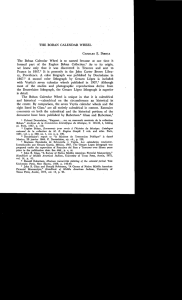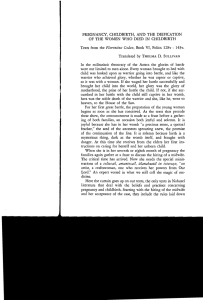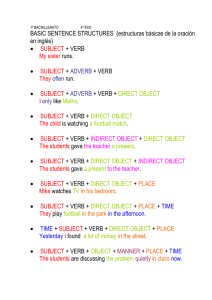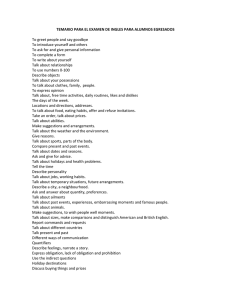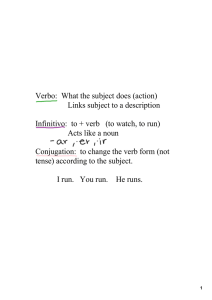THE DISCOVERY OF CORN It is man`s nature to wonder about the
Anuncio
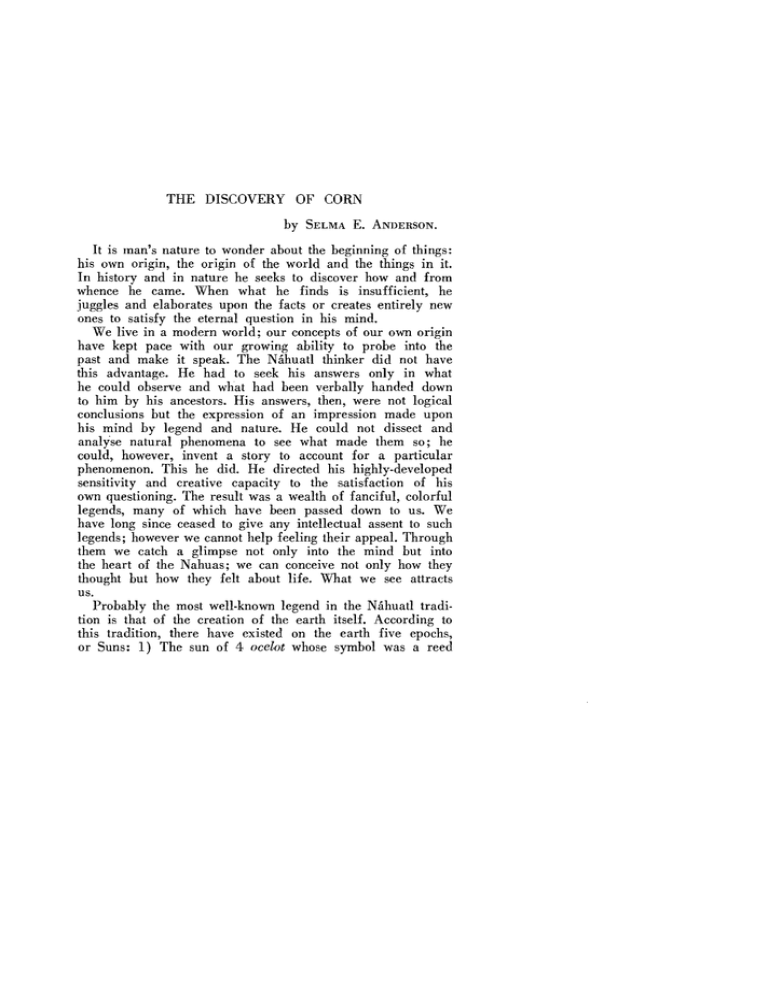
THE DISCOVERY OF CORN by SELMA E. ANDERSON. It is man's nature to wonder about the beginning of things: his own origin, the origin of the world and the things in it. In history and in nature he seeks to discover how and from whence he carne. When what he finds is insufficient, he juggles and elaborates upon the facts or creates entirely new ones to satisfy the eternal question in his mind. We live in a modern world; our concepts of our own origin have kept pace with our growing ability to probe into the past and make it speak. The Náhuatl thinker did not have this advantage. He had to seek his answers only in what he could observe and what had be en verbal1y handed down to him by his ancestors. His answers, then, were not logical conclusions but the expression of an impression made upon his mind by legend and nature. He could not dissect and analyse natural phenomena to see what made them so; he could, however, invent a story to account for a particular phenomenon. This he did. He directed his highly-developed sensitivity and creative capacity to the satisfaction of his own questioning. The result was a weahh of fanciful, colorful legends, many of which have been passed down to uso We have long since ceased to give any intellectual assent to such legends; however we cannot help feeling their appeal. Through them we catch a glimpse not only into the mind but into the heart of the Nahuas; we can conceive not only how they thought but how they feh about IHe. What we see attracts uso Probably the most well·known legend in the Náhuatl tradi­ tion is that of the creation of the earth itself. According to this tradition, there have existed on the earth five epochs, or Suns: 1) The sun of 4 ocelot whose symbol was a reed 178 ESTUDIOS DE CULTURA NÁHUATL and which ended with its inhabitants being devoured by ti­ gers, 2) the Sun of 4 Wind, symbolized by flint and ended by great winds, 3) the Sun of 4 Rain wbich was destroyed by a rain of fire, 4) the Sun of 4 Water, symbolized by a house and destroyed by water. The fifth Sun, that of Move­ ment, is the present age, and was created in Teotihuacan at the whim of the four sons of Ometeotl the Dual godo This is the legend: Two of these gods, Tezcatlipoca and Quetzal­ cootl, sent down from heaven the Goddess of the Earth, a horrible monster full of eyes and biting mouths. The earth was then full of water, left from the previous destruction, and over the water moved the monster. The two gods decided that the earth must be given form; whereupon they transformed themselves into two enormous serpents. One of them took the Monster by her right hand and left foot, and the other took her by the left hand and right fool. Together they stretched and pulled until she separated into two parts. The lower part rose and formed the heavens; the upper part formed the earth. Then the rest of the gods descended to console the Goddess of the Earth and to give her gifts. In compensation for her sacrifice it was permitted that from her body should come all that which man needed to live in the world. Her hair became grass, trees and flowers. Her skin became the grass of the meadows and the flowers that adorn it. Her eyes became small caves, cisterns and springs; her mouth, large caves. Her nose was transformed into mountains and valleys.l After the world was created there was a need of man to inhabit it. There are various legends as to the origin of man himself. To relate two: One day early in the morning the Sun threw an arrow from heaven. From the opening it made in the rock where it landed rose aman and a woman. Both were incomplete, however, being created only from the chest up. These two went leaping over the fields and latter, through the union of a kiss, was born aman who was the ancestor of aH men. 2 Another which attributes the creation to Quetzalcootl: One day Quetzalcóatl went to Míctlan (the land of the 1 Epica Náhuatl, compiled hy Angel María Garihay K., U. N. A. M., Mex., 1945, pp. 3-4. 2 lbíd., pp. 7-8. TRE DISCOVERY OF CORN 179 dead). He approached Mictlantecutli and Mictlancíhuatl, the lord and lady of the land of the dead, and demanded the precious bones that they guarded. When asked what he wanted with them, Quetzalcóatl replied that the gods were worried that there were no men on the earth. Mictlantecutli responded that he would give him the bones if he would make his snail shell to sound and if he circled his magic cirde four times. The shell had no holes; therefore Quetzalcóatl summo­ ned the worms to make holes. Then the bees entered the shell and with their humming made it sound; at which Mictlante­ cutli gave him permission to take the bones. Later he repented and wished for Quetzalcóatl to return them, but he refused and fled with the bones. Mictlantecutli sent his servants ahead to prepare a pitfall for Quetzalcóatl. He fell dead into the pit and the scattered bones were pecked and damaged by quail. Later Quetzalcóatl revived, gathered the remains of the bones and took them to TalTWanchan. There Cihuacóatl ground them and put them in a precious vessel. Quetzalcóatl sprinkled them with his own blood and the other gods an did penance. From this was born mano Therefore man was created through the penitence of the gods. To live, man must eat. Thus rose legends accounting fOI the abundance of food found on the earth. The legend which I have translated has to do with that which was, for the Indian, by far the most important of his foods: corno In each of the five epochs a particular food had been pro­ vided for the people: in the first Sun, this food was acorns; in the second, aciciutli, a seed resembling wheat which grew in the water ("water corn"); in the third a seed similar to corn called cincocopi ("almost corn"). As is evident, the sustenance of each succeding epoch had evolved more and more toward the corn of today. We are not told the name of the food of the fourth epoch, but we may assume that it followed this evolution. And in the fifth Sun, the Sun of 4 Movement, appeared corn in its modern form, created by the gods and given to man by Quetzalcóatl. It has be en said that as wheat is the basis of European alimentation and rice of the Orient, corn (probably first developed in MesoAmerica) as basic food of the Western Hemisphere. In the Indian cultures of Mexico ihis economic dependence is most pronounced. And certainly in Pre-Conquest 180 ESTUDIOS DE CULTURA NÁHUATL times befo re the invasion of modern products the importance of maize to the Indian's subsistence must have be en even greater. The tlaxcalli (tortilla), along with the etl: frijol (bean) formed the greater part of the daily faresuplemented by more corn products: atole, tamales, elotes, etc. NaturaHy a product so essential to the maintenance of life was bound to be echoed in the cultural and economic activi­ ties of the people. The Indian man's daily life revolved around the care of his corn crop; the woman's around the preparation of tortillas. If the crop failed, the people went hungry; therefore the utmost care was taken to keep happy aH the gods who had any influence on the corn crop. The legend of how their "staff of life" carne to be must have been one of the most beloved in the folklore of the nahuas. It has come down to us as a delightfully fantastic and colorful liule tale. The figure of Quetzalcóatl as Providor is significant; he was looked upon by the nahuas as the creator-benefactor of the early toltecs. It is he who brought agriculture, cultural development, and a period of general plenty in the Valley of Mexico. This powerful figure nego­ tiating with the tiny ant, the towering mountain with its store of corn, Cipactonal and Oxomoco casting lots, Nanáhuatl pee­ ring at the situation from aboye and dramatically splitting open the mountain, and the colorful TlaUoques (gods of rain) coming from the four corners of the earth to snatch the exposed corn- all of these paint a picture in our minds of considerable color and drama. How much more it must have excited the people who created it and believed it! 1. 2. 3. 4. 5. 6. 7. 8. 9. 10. n. 12. 13. Ye no ce(p)pa quitoque: ¿ Tlein quicuazque, teteoye? Ye tlatemohua in tonacayotl. Auh niman quicuito in azcatl In tlaolli in itic tonacatepetl. Auh niman ye quinamique in azcatl in Quetzalcohuatl. Quilhui: Can oticcuito? Xinechilhui. Auh amo quilhuiznequi. Cenca quitequitlatlania Niman ic quilhuia: Ca, nechca. Niman ye quihuica, THE DISCOVERY OF CORN 14. 15. 16. 17. 18. 19. 20. 21. 22. 23. 24. 25. 26. 27. 28. 29. 30. 31. 32. 33. 34. 35. 36. 37. 38. 39. 40. 41. 42. 43. 44. 45. 46. 47. 48. 49. Auh niman ie tlilazeatl moeuep In Quetzaleohuatl Niman ye quihuiea, Niman ye ie eallaqui. Niman ye ie quizazaea nehuan. In tlatlauhqui azeatl in maeh oquihuieae in Quetzaleohuatl tlatempan quitlatlalilia in tlaolli. Niman ye quitqui in Tamoanehan Aun niman ye quieuaeua in teteo. Niman ye ie toteneo quitlalia inie tihuapahuaque. Auh niman ye quitohua, Quen tieehihuazque in tonaeatepetl? Auh niman zan ya quimanaznequi. In Quetzaleohuatl quimeeayoti, auh amo queuh. Auh niman ye quitlapohuia In Oxomoeo. Auh niman no ye quitonalpohuia in Cipaetonal, in ieihuauh Oxomoeo. Ca eihuatl in Cipaetonal. Auh niman quito que in Oxomoeo in Cipaetonal. Ca zan quihuitequiz in Nanahuatl in tonaeatepetl ca oquitlapohuique. Auh nima(n) ye netlalhuilo in tlaloque In xoxouhqui tlaloque, iztae tlaloque, eozauhqui tlaloque, tlatlauhqui tlaloque. Niman ye quihuiteque in Nanahuatl Auh niman ye namoyello in tlalloque in tonaeayotl. In iztae, in yahuitl, in eoztie, in xiuhtoetli, in etl, in huauhtli, in ehian in miehihuauhtli. Ixquieh namoyaloe in tonaeayotl. Translation: l. 2. 181 Thus once more (the gods) said: What shall they eat, O gods? 182 ESTUDIOS DE CULTURA NÁHUATL 3. Let our sustenance come down. 4. And then the ant goes to gather 5. Shelled corn from within the mountain of our sus­ [tenance. 6. Quetzalcóatl affronts the ant. 7. He asks him: 8. Where did you go to gather it? Tell me! 9. But he does not wish to tell him. 10. (Quetzalcóatl) urges him. 11. Then he says: 12. "Well ... there!" 13. Whereupon he takes him. 14. Promptly Quezalcóatl changes himself into a black ant. 15. Then he guides him, 16. And thus introduces him (to the corn.) 17. They go, out together. 18. It is said that the red ant 19. Guided Quetzalcóatl 20. To the foot of the mountain where they placed the [corno 21. Then he (Quetzalcóatl) carries it on his back to Ta­ [moanchan. 22. Wnereupon the gods eat and eat. 23. Then they put it into our mouths 24. So that we might be made strong. 25. And then they say 26. "What shall we do with the Mount of our sustenance? 27. For now it will only wish to remain where it is." 28. Quetzalcóatl pulls at it, 29. But he cannot (move it.) 30. Then Oxomoco 31. Draws lots. 32. And likewise Cipactonal, the wife of 33. Oxomoco, draws 10ts. 34. (For Cipactonal is a woman.) 35. Oxomoco and 36. Cipactonal say: 37. "If only Naniihuatl will send a bolt of lightning 38. To the Mount of our sustenance. (Because we drew [10ts.) " 39. Then the gods of rain were gathered together: THE DISCOVERY OF CORN 40. 41. 42. 43. 44. 45. 46. 47. 48. 49. 183 The blue.green gods of rain, The white gods of rain, the yellow gods of ram, The red gods of rain. At once Nenáhuatl sends a lightning bolt. Then our sustenance was stolen By the gods of rain. The white, the dark corn, the yellow, The red corn, the bean, the blades, The oil-giving seeds: AH our sustenance was stolen (for us.) Grammatical and ideological analysis 1. Ye TU) ce( p) pa quitoque Thus once more (the gods) said Ye: So, thus; at end of a verb, indicates vocative case rw: also ce(p)pa: Once; at one time qu-ito-que: qu- from qui, relative particle ito- verb itoa: to say que- added to the verb, indicates plural The Náhuatl pantheon was quite extensive. The gods stem from the great dual god Ometeotl, with his masculine and feminine forms of Ometecuhtli and Omecihuatl, respectively. From this dual god carne four sons, originally the four Tez­ catlipocas of different colors. Later on in Aztec thought they became Tezcatlipoca, (Lord of the smoking mirror), Quet­ zalcóatl (feathered serpent), Tlaloc, and Huitzilopochtli. The rest of the gods likewise stem from or were related to these, sometimes as different phases or feminine counterparts of these same gods. 2. tlein quicuazque teteoye? What shall they eat, O gods? tlein: what qui-cua-z-que: quí- relative particle cua- to eat z- at end of verb, indicates future tense que- particle indicating the plural 184 ESTUDIOS DE CULTURA NÁHUATL teteo-ye: 3. teteo: teo, god; teteo, gods. Plural formed by the repetition of a syllable. ye- vocative particle Ye tlatemohua in tonaeayotl Let our sustenance come down Ye: So, thus. tla-tema-hua : tla- indicates the presence of a non-personal object temo- to descend or come down. Intransitive (temouia- to bring something down) (o)hua- indicates impersonal VOlce to-naea-yotZ: to- possessive pronoun: our naeayotl- food, sustenance naea (tI) - meat, food yotl- suffix denoting an abstract or collec­ ti ve noun. Here the sense is not so much of the sustenance, or food literally descending from above, but rather being províded with a similar connotation as "give us. .. our daily bread". 4. auh níman quieuito in azeatl And then the ant goes to gather auh: then (copulative or implicative, not temporal) then; thereupon; thereafter nzman: qui-eui-to : quí- relative particle euí- to take (with the sense oi taking with the hand) to- particle indicating action away irom the subject: goes to gather. 5. tlaolli in ític tonacatepetl 5helled corn from within the Mountain oi our sustenance shelled, dried corn variable particle, roughy equivalent to the article in English. itic: within to-naca-tepetl: tO- our naea (tI) - sustenance tepetl- hill or mountain tlaollí: m: THE DISCOVERY OF CORN 185 Here the corn is already in existence. According to legend, it was first created in this manner: One day the gods des­ cended into a cavern. From the union of the god Xochipilli (Princechild) and the goddess Xochiquetzal (Precious flo­ wer) was born a god called the God of Corno This god was buried in the earth and from his ha ir, ears, nose, etc. sprang cotton, seeds, and various items basic to life. From his nails carne the corn which is the foundation of human sustenance. 3 6-7. Auh niman ye quinamiqui in Quetzalcóatl affronts the azcatl in Quetzalcohuatl. ant. He asks him: Quilhui: Auh: mman: ye: azcatl: Qu-ilhui: then then; thereupon; thereafter temporal particle- verbal form of yauh: then, befo re, etc. niman ic (or niman ye ic) modal expre­ ssion: "for this", or temporal "inmedia­ tel y after that-" qui- relative particle namiqui- to encounter someone; to come to meet. ant qu: qui- relative particle ilhui- verb ilhuia: to say; to tell. Quetzalcóatl is one of the most important and most con­ fusing of the ancient gods. As mentioned aboye, he is said to have been one of the four sons of Ometeotl and to have fulfilled a creative function in the history of the nahuas. However, there is another tradition that says he was a bearded, whiteskinned human who arrived by boat on the eastern coast of Mexico and who later fled in the direction from which he carne in a boat made of serpents. 4 Whatever his origin, he is remembered as a kind and beneficient god, opposed to human sacrifice, who brought with him abundance and happi­ ness and who taught his people the arts of weaving, metal Ibíd., p. 5. History 01 the Conquest 01 Mexico, Modern Library, Random House, U. S. A. 3 4 PRESCOTT, 186 ESTUDIOS DE CULTURA NÁHUATL working, government and many others. Rere he provides the people wíth their basic food. 8. oan oticcuito? Xinechilhui! Where did you go to gather ít? Tell me! can: where. AIso is a locatíve suffix, as in Coyo­ huacan- "the place of those who have coy'otes" o·ti·c·cui-to: o- indicates simple past tense ti- índicates second person singular c- indica tes presence of a complement or direct object. cuí. to take or gather to- indicates action away from: "go to take" Xi-nech·ilhui: xi- partícle denoting the imperative mood nech- "to me" -object of the action ilhuí- verb ilhuia: to teH, to sayo 9. Auh amo quilhuiznequi. But he does not wish to tell him. Auh: then amo: no; negative qu-ilhui-z-nequi: qu· qui: relative particle ilhui· to say; to tell (verb ilhuia) z- indicates future. Not translated with the future tense in English but witb future implication. nequi. to want or wish something. (Formation of verb plus infinitive (wish to tell) by using a future tense with a presento (ilhuiz-nequi) 10. Cenca quitequitlatlania. (Quetzalcootl) urges him. cenca: much; very qui-tequi-tlatlania: tequi- to cut. Sometimes used to imply insistence tlatlania- to ask (something of so· meone) THE DISCOVERY OF CORN 11. Niman ~c quilhuia: 187 Then he says: íc: ior which; because oi which. Níman ic: then. qu.ilhuia: qu· quío relative particle ilhuia· to say, to tell 12. Ca, nechca! "Well there!" Ca: affirmative adverb: well, yes, so. lt is also a verbal form of "to be", i. c. "to exist." nechca: there. (location) 13-14. Niman re quihuica, Whereupon he takes him; Auh niman ic tlilazcatl mocuep in Quetzalcohuatl. promptly Quetzalcóatl changes himself into a hlack ant. N iman re; niman ic: then; inmediately qui-huica: quí- relative huíca: to carry or take (guide) something or someone tlilazcatl: black ant. mO- reflexive mo-cuep: cuep- verb cuepa: to transformo 15-16. mman re quihuica Then he guides him, and mman re íc callaqui. thus introduces him (to the corn) call-aqui: calli- house aqui- enter "enter into the hou>;:e" Literally to put within: to introduce. 17. Niman re ic quizazaca nehuan. They go out together. quiza-zaca: quiza. verb quixtia: to take (something) out; to leave. za· repeated to show intensity or repetition of action. ca· indicates permanent action. 188 18. ESTUDIOS DE CULTURA NÁHUATL In tlatlauhquiazcatl in mach It is said that the red ant. tlatlauhquí-azcatl: tlatlauhqui: red azcatl: ant mach: it is said, one says, they sayo (Rare form) 19. oquihuicac in Quetzalcohuatl Guided Quetzalcootl o-qui-huica-c: Q- indicates simple past tense quí- relative huica- verb (h)uica: to take, to guide c- also indicates simple past tense corres­ ponding suffix. 20. tlatempan quitlatlalilia in tlaoUí to the foot of the mountain where they placed the corno tla-tem-pan: tla- indicates presence of an object tem- from tentli: lip, edge. (place of en­ trance) pan- shows relation of direction or destina­ tion "towards" or "in" something. qui-tla-tlal-ia: quí- indicates plural: they tla- repeated syllable. tlal (ia) - to put or place ia- indicates imperfect tense tlaollí: shelled, dry corno 21. mman ye quitqui in Tamoanchan. The he (Quetzal­ cóatl) carries it on his back to T amo­ anchan. qu-itqui: quí- relative itqui- to carry upon the shoulders or back Tamoanchan ("horne frorn which we descend") 5 seems to be a mythical, mystical place of origin of the nahuas. It is 5 LEÓN-PORTILLA, Miguel: La Filosofía Náhuatl estudiada en sus fuentes, México, 1956, p. 320_ THE DISCOVERY OF CORN 189 said to be the first city that the first persons established who came by beats over the sea- or in other words, the place fmm which procede all other cities. It is sometimes identified with Omeyocan, place of duality with Tlalocan, the mythical paradise. 6 22. Auh nirrwn ye quicuacua in teteo Whereupon the gods eat and eal. qw-cua-cua: qui- relative cua- to eat cua- to eat, sense of repetition or abundance by the repetition of the verbo "To chew" te-teo: teo- god; teteo, gods 23-24. niman ye ic totenco quitlalia Then they put lt mto inic tihuapahuaque. our mouths so that we might be made strong. to-tenco: to- our tenco- mouth (site of the lips ) ten(tli)- lip; co- locative suffix qui-tlalia: quí- relative tlalia- to put or place. (This time the tla indicating the object is omitted) . m~c: in order that; so that ti-huapahua-que: ti- we huapahua- to fortify; to make strong que- at end of verb, indicates plural 25. Auh niman ye quitohua And then they say qu-ito-hua: quí- relative ita- verb itaa, to say hua- indicates impersonal voice (impersonal they). 26. Quen ticchihuazque in tonacatepetl "What shall we do with the Mount of our sustenance" El Loe. cit. 190 ESTUDIOS DE CULTURA NÁHUATL Quen: how; what; in what nanner ti-c-chihua-z-que: ti- we e- indicates presence of an object ehihua- to do (something) z- indicates future tense que- denotes plural of the verbo tO.TUlca.tepetl: too our TUlea (tl). meat, sustenance tepetl- hill, mountain (Ordinarily with the addition of a prefix (here the possessi­ ve to) the "tl" ending of the noun is lost. In this particular case it is retained.) 27. auh niman zan ya quimanaznequi For now it will only wish to remain whe· re it is. zan: ya: only temporal particle- verbal form of yauh; then, befo re, now, etc. qui.maTUl.z-nequi: quí- relative maTUl- to stay; to remain z- indicates future nequi- to wish, to want (Again the future plus present tense [manaznequi] express a verb plus an infinitive [wish to remain].) 28·29. to in Quetzalcohuatl quim.eeayoti, Quetzalcoatl pulls at auh amo queuh. it but he cannot (mo­ ve it). qui·mecayoti: quío relative meeayoti- from meeatl, cord; meca· yotl, abstract form ("lineage"); me­ cayoti, verbal formo Meaning: to pullo auh: then, but amo: negative; no qu.euh: qu. relative euh· verb ehua, to be able. AIso means "to lift." THE DISCOVERY OF CORN 30-31. Auh niman ye quitlapohuia in Oxomoco. 191 Then Oxomoco draws lots. qui-tlapohuia: quí- relative tlapohuia- to draw lots tla- indicates object pohuia- to count 32-33-34. And likewise Cipacto­ Auh inman no ye quitonalpohuia in Cipactonal, in icihuauh Oxomoco nal, the wife of Oxo­ moco, draws lots. Ca cihuatl in Cipactonal. (For Cipactonal lS a woman.) Auh niman no ye: then also; likewise qui-tonal-pohuia : quí- relative tonal- from tonalli, day, destiny, or lot pohuia- to count. The compound verb means "to deci­ pher" or "to prognosticate" (to count destinies): to cast lots i- his i-cihua-uh: cihua- from cihuatl, woman; wife uh- possessive suffix because, for (conj.) ca: Commentary on lines 32-33-34: Cipactonal and Oxomoco are the "Adan and Eve" of the Nahuas. They were begotten at the same time by Ometecuhtli the supreme dual god and were ordered one to cultivate the earth and the other to sew and weave. They had magical powers which they taught to men, sometimes using grains of corn in their encantations. 7 They were also charged, along with Quetzalcáatl, with the creation of the Mexican Calendar. And it was these same two gods who taught astrology and the use of medicinal herbs to the toltecs. There seems to be sorne controversy over which of the two was masculine and 7 Diccionario de Mitología Náhuatl, compílerl ¡"v Robelo, C. A., Mexico, 1911, p. 104. 192 ESTUDIOS DE CULTURA NÁHUATL which feminine. Most of the texts indicate that Oxomoco was the male, Cípactonal the female. 8 However, Sahagún contra­ dicts this point and reports Oxomoco as being female and Cipactonal, male. 9 Line 34 seems to bear on this point. The line in its context seems to make very Httle sence unless taken as a parenthetical express ion emphasising the femininity of Cipactonal. 35·36. auh niman quítoque in Cipactonal tU Oxomoco Oxomoco and Cí­ pactonal say: qu-ito-que: qu- relative ito- verb ieoa, to say, to tell que- indicates plural 37. ca zan quihuitequiz in Nanáhuatl If only Nanáhuatl will send a bolt of lightning. ca: if zan: only qui-(h)uitequi-z: quí- relative (h)uitequi- from Vitequi, to punish, to wound- or to send a lightning bolt. z- indicates future tense Nanáhuatl means "the one covered with sores". It is he who was converted into the 5th Sun, in this manner: Before tbe era of the fifth sun, everything was dark. The gods gathered at Teotihuacan and determined to create a sun. Tbey asked for volunteers among the gods to form this new sun. Inmediately the Snail Cod volunteered, but no oneelse was willing; all were afraid. Finally Nanáhuatl was picked as the other candidate. The two gods fasted and did penance for four days- the Snail Cod with elaborate instruments and ceremonies, and Nanáhuatl with plain maguey thoms 8 Historia de los mexicanos por sus pintu.ras, Nueva Colección de Docu­ mentos para la Historia de México, 11I, pp. 228-229; also, Anales de Cuauh­ titlan, Translation by Velázquez, Mexico, 1945, p. 4. 9 SAHAGÚN, Historia de las cosas de la Nueva España, V. 1, p. 307. THE DISCOVERY OF CORN 193 and with real sacrifice. At the end of the four days, the two gods were dressed for the ordeal- the Snail God in elegant finery, and Nanáhuatl in garments of papero Both stood facing the enormous fire which had been prepared during their four days Qf penance. The gods gave the signal for the Snail God to cast himself into the fire. He ran towards the flames, but upon nearing, the flames and heat filled him with such fear that he turned back. Again he ran toward the fire and again turned back. A third and a fourth time he tried and failed and the gods refused him another chanceo Then it was N anáhuatl' s turno He closed his eyes to keep from being afraid, ran directly toward the fire and threw himself in. At this, the Snail God was so ashamed that he also threw himself in the fire. As the flames consumed them, the gods waited to see emerge the new sun. Finally it rose in the East, and with it carne the first dawn of the fifth era. Since N aná· huatl had thrown himself into the fire first, naturally he was the first to be converted into a sun. But the Snail God followed him, equally bright although in a secondary position. This did not seem right to the gods, so they wounded the face of the Snail God with a rabbit and formed the lesser light of the Monn. 10 38. in tonacatepetl ca oquitlapohuique te the Mount of our sustenance (Because we drew lots) o-qui-tlapohui-que: o- indicates past tense quí- relative tlapohui( aJ- to cast or draw lots que- indicates plural 39. auh nima(nJ ye netlalhuilo in tlaloque Then the gods of rain were gathered together ne-tlalhui-lo: ne- indefinite personal pronoun. Here il has almost a reflexive function-to gather themelves together. tlalhui(aJ- to summon or call together; or to gather in one place. Here, because 10 Epica Náhuall, op. cie., pp. 11·19. 194 ESTUDIOS DE CULTURA NÁHUATL of the particle ne the latter meamng seems most likely. lo- indicates passive voice. The tlaloques were the gods of rain subject to Tláloc, the Lord of the Rain and of the East, and king of Tlalocan, the earthly paradise-- also sometimes designated as the after­ world in which dwell all those who on earth met their death by water. Tláloc was charged with making fertile and lush all the earth. 40·41·42. In xoxouhqui tlaloque, iztac tlaloque, cozauhqui tlaloque, tlatlauhqui tlaloque. xoxouhqui: iztac: cozauhqui: tlatlauhqui: the blue-green gods of rain, the white gods of rain, the yellow gods of rain, the red gods of rain. blue-green white yellow red The nahuas divided their universe into four sections corres­ ponding to the cardinal points. Rather than being a simple direction, however, each "point" included a quedrant of the eart -a quadrant formed by the horizontal division of the earth with a large X. To each quadrant, or direction, was assigned a color: to the east, red; to the north, black, to the west, white; and to the south, blue. Thus the representative colors of the tlaloques. 43. niman ye quihuitequi in Nanáhuatl At once Nanáhuatl sends a lightning bolt. qui-huitequi: quí- relative huitequi: to punish, to wound, or to send a bolt of lightning. 44·45. auh niman ye namoyello in tlalloque Then our sustenance in tonacayotl was stolen by the gods of rain. THE DISCOVERY OF CORN 195 namo.ye- (l) lo: namo ( ya). to robo ye. thus- adds emphasis (l) lo. passive voice. 46-47-48. In iztae, in yahuitl, in coztie, In xiuhtocli in etl in huauhtli, In chian in michihuauhtli. The white, the dark corn, the yellow, the red corn, the bean, the blades, the oil-giving seeds: 49. ixquich namoyaloc in tonacayotl AH our sustenance was stolen (for us) namoya.lo.e: namoya· to rob lo. indicates passive voice e- indicates past tense to-naea-yotZ: too our naca· sustenance yotl- suffix denoting collective noun. t SIMBOLISMO DE 1 Dibl FOtOgI \¡ Los colores, núm mordíal en los co mágico del nativo una función precis~ prema trinidad del días, la fusión de 11 La vida materia antoja un mural CI en que se logra la a y cada uno de los y su razón de ser, ) dad y belleza al co: dad indígena. No CI armoniosa y total I base de la integrid El simbolismo de sado en observaciol parte esencial de lo exotéricas: el canto Las observacione! miento y Religión, turas clásicas mesol
